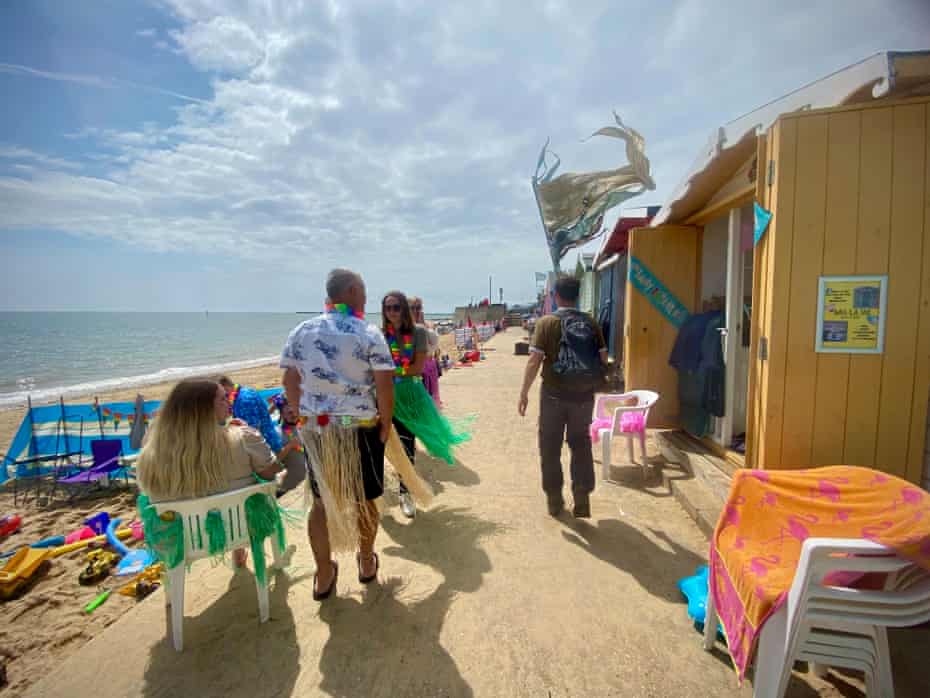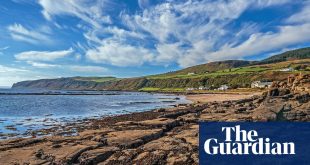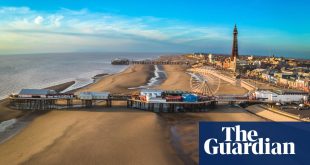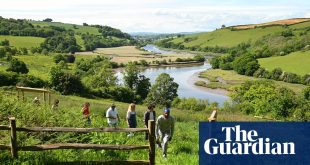I stand aside to let a tractor go past down the lane and only then notice the field of sunflowers. There is a sign out front: Please help yourself.
I wander up the side of the plot and stand among thousands of yellow flower heads, nodding gently in the breeze under an almost-blue sky. In the distance I can hear the sounds of London Gateway port, where ships as huge as the Ever Given can dock (the Suez canal blocker recently arrived at Felixstowe), but for a moment, I might be in Provence.
This generous sign has thrown me, made me aware of how hostile the landscape of our 500-mile Beach of Dreams walk around the coasts of Suffolk and Essex has become: paths choked with nettles, vandalised footpath markers, unhelpful and obstructive landowners – and golf club members who bellow in fury as we cross their course, on a public path, after waiting for them to play.

Only a few miles back there was a bullish notice in large letters on a sheet of chipboard: Keep to the Footpath. Private Property. Behind it, in a nest of head-high nettles, was the footpath. At several points landowners have simply cordoned off beach areas for their sole pleasure, sometimes mystifyingly: at one spot all that exists is a foul stretch of mud dotted with broken concrete and, in the middle, a Private notice.
In a pandemic period when people are walking more than ever, and England’s coastal footpath is supposed to come to fruition, my experience on our coastal trek from Lowestoft to Tilbury is that the phrase KEEP OUT runs through the landscape, like the words in a stick of seaside rock. Even on an important path like the one between Flatford Mill – where John Constable painted his images of rural England – and nearby Manningtree, the way is being kept open by a local man with a pair of clippers who has despaired of help from the relevant authorities.
And yet there is great walking to be had: the route around Mersea Island, with its oyster cafes and vineyards; the remote and austere Dengie peninsula; and the ancient oaks between Manningtree and Harwich. The biggest surprise was how much I loved the 10-mile stretch of concrete sea wall between Walton-on-the-Naze and Jaywick, an array of colourful beach huts and traditional seaside fun, taking in Frinton-on-Sea and Clacton. Equally shocking was how good Essex wine is.

Other small towns and villages have been a revelation: places such as Tollesbury, Maldon, Burnham, Wivenhoe and Bradwell, each with its own character and interest. Thatched roofs and neatly painted weatherboard walls in unspoiled high streets – I had not expected that – and we were always close to vast numbers of boats. Sailing is a passion here, second only to doing boat repairs and renovations.
The people, apart from a few curmudgeonly landowners, have been magnificent: when word spread of our epic hike, dinners turned up unannounced, laundry was done, cakes were sent over in cafes, but most of all, there was tons of good humour and company on the long miles.
When it comes to wildlife, the trek has revealed a mixed picture. There are dozens of bird reserves, most of them for shore birds. Step inland, however, and things are less rosy. We spent hours circumambulating hectares of golden wheat, or sometimes using the path that the farmer had cut. On closer inspection, this wonderful harvest looked less than healthy – “ripening” is often brought on by herbicides these days. There are few insects to be seen, and consequently few birds. I did not spot a single amphibian until the last few miles, when a common lizard shot across the path – outside Rainham landfill site.

In south Essex, along the Thames estuary, the nuggets of beauty stand out more starkly in a post-industrial landscape that is throwing itself into a period of frenetic development. Leigh-on-Sea is well known for its cockle shacks and traditional boats, but further along are lovely country parks such as Hadleigh Castle and the Langdon hills.
Even in the most unlikely places, there is interest. The town of Grays is not noted as a tourist hotspot but its collection of world food shops and restaurants makes it worth checking out. A walk up the Thames beside the sea wall is a must for anyone interested in folk art. This unplanned and unofficial gem of graffiti stretches without interruption for miles. Along the way you will come across a church: the 13th-century St Clement’s, sandwiched between a soap factory and a warehouse – a fabulously incongruous juxtaposition that made it a memorable film location in Four Weddings and a Funeral.

In the graveyard of St Clement’s I meet Fotis, a London-based film-maker originally from Greece, who is on something of a pilgrimage.
“This place means a lot to me. What other country would put a soap factory next to an ancient church? It’s amazing. I love it.”
I would say it’s not Britain, but Essex. Where else would you see an astroturf lawn in an otherwise perfect country garden, or a skeleton sitting in a classic car on a country lane? The irreverence and humour are never far away. On this five-week walk, for hundreds of miles around its coast, Essex has never failed to amuse, appal, impress and infuriate, often simultaneously. Go and see for yourself.
Kevin’s walk is documented in a daily blog. For more information visit visitsuffolk.com and visitessex.com
 Top Naija News – Nigeria News, Nigerian News & Top Stories Top Naija News – Nigerian Newspapers, Nigerian News. topnaijanews is a daily Nigerian newspaper covering Latest News, Breaking News, Entertainment, Sports, Lifestyle and Politics.
Top Naija News – Nigeria News, Nigerian News & Top Stories Top Naija News – Nigerian Newspapers, Nigerian News. topnaijanews is a daily Nigerian newspaper covering Latest News, Breaking News, Entertainment, Sports, Lifestyle and Politics.



